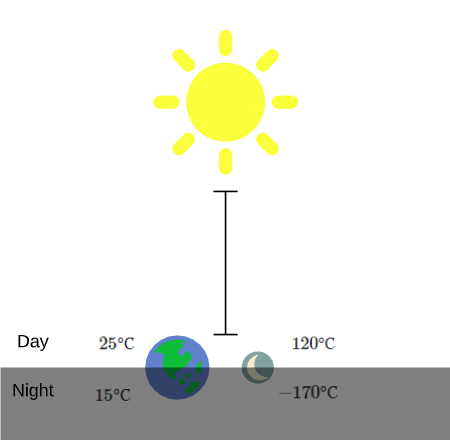How does CO2 cause global warming?
Shopless is a NZ free marketplace,
we are also a social enterprise, donating half of our
revenue to NGOs who are fighting against global warming
and/or helping refugees.
We have tried our best to explain, in simple words, the most fundamental question about global warming: How does CO2 cause global warming?
Background
We know that the planets of Solar System are receiving their heat from the Sun, we also know that the closer we get to the Sun the hotter it gets… as an example, the temperatures at Mercury (the closest planet to the Sun) can reach up to 427°C.
Now, the Moon and the Earth are roughly the same distance from the Sun, so one would expect to have similar temperatures on the Moon as we have on the Earth… but that’s not the case!

Temperatures on the moon change from 120°C during the day to -170°C during the night
Temperatures on the Moon are extreme, ranging from boiling hot (120°C) during the day to subfreezing cold (-170°C) during the night! The question is why do we not experience such extreme temperatures on the Earth?
The reason is that Earth has an atmosphere which acts as an insulation layer around us. It cools us during the day by blocking the harmful radiations of the Sun and it warms us during the night by keeping the heat from escaping. It’s a phenomenal insulation layer, which works in our favour both ways.
But how can the atmosphere keep us both cool (day time) and warm (night time)? To answer this question, we need to understand the radiation of objects:
Any object with a temperature above absolute zero loses heat in the form of radiation. If the object is very hot (like the Sun) it loses more energy by radiating a more powerful wave, such as visible light.

Sun is very hot and radiates high energy (high frequency) waves such as visible light
If the object is cooler (like the Earth) it loses heat by radiating a less powerful wave such as infrared.

Earth is cooler than the Sun, and radiates lower energy (lower frequency) infrared waves
If like me, you have difficulty picturing the Earth radiating infrared waves, think of the animal documentaries, where they use infrared cameras to film the animals in the dark… the animals are radiating infrared waves and that’s how we can film them… just like the animals, the Earth itself is losing energy by emitting infrared waves.
How does CO2 cause global warming?
The atmosphere surrounding the Earth contains greenhouse gases such as water vapour and CO2. Light can go through GH gases (because of its high energy level) but an infrared wave could get bounced back off a GH gas (technically the GH gas absorbs and re-emits the infrared energy at a random direction).

So just like the glass surrounding a greenhouse, the atmosphere preserves Earth’s heat by blocking a portion of infrared waves from escaping. Now what would happen if we start adding more and more GH gas (such as CO2) into the atmosphere? The more GH gas, the less infrared waves which can escape the atmosphere… which means the Earth would lose less heat… and that’s the cause of global warming.
How is global warming accelerating?
We know that the white surface of polar ice reflects the light back into the space, just like a mirror… but as the Earth’s temperature rises, the ice would melt and the white surface of the oceans would shrink… this would lead into more absorption of light by the dark surface of the oceans, which in turn would cause the Earth’s temperature to rise… and this cycle would accelerate itself.
At the same time, we know that the plants take in CO2, water and sunlight and produce oxygen and food through a process called photosynthesis. The plants are responsible for taking CO2 off the air… but as the temperature rises, we are getting more bush fires… the bush fires would produce more CO2… at the same time, they destroy the plant which was responsible to reduce the level of CO2 in the air… this in turn would raise the temperature which has caused the bush fire…
It’s not too late…
The UN Intergovernmental Panel on Climate Change, has warned us that we have 11 years left to prevent irreversible damage from climate change. We need to realize that there is a big responsibility on our shoulder as we are the last generation who can prevent irreparable damage to our planet.
Hooman Bahreini,


 Business Canterbury: Urges Council To Cut Costs, Not Ambition For City
Business Canterbury: Urges Council To Cut Costs, Not Ambition For City Wellington Airport: On Track For Net Zero Emissions By 2028
Wellington Airport: On Track For Net Zero Emissions By 2028 Landcare Research: ANZAC Gall Fly Release Promises Natural Solution To Weed Threat
Landcare Research: ANZAC Gall Fly Release Promises Natural Solution To Weed Threat NZ Anti-Vivisection Society: Auckland Rat Lovers Unite!
NZ Anti-Vivisection Society: Auckland Rat Lovers Unite! University of Canterbury: $1.35 Million Grant To Study Lion-like Jumping Spiders
University of Canterbury: $1.35 Million Grant To Study Lion-like Jumping Spiders Federated Farmers: Government Ends War On Farming
Federated Farmers: Government Ends War On Farming



